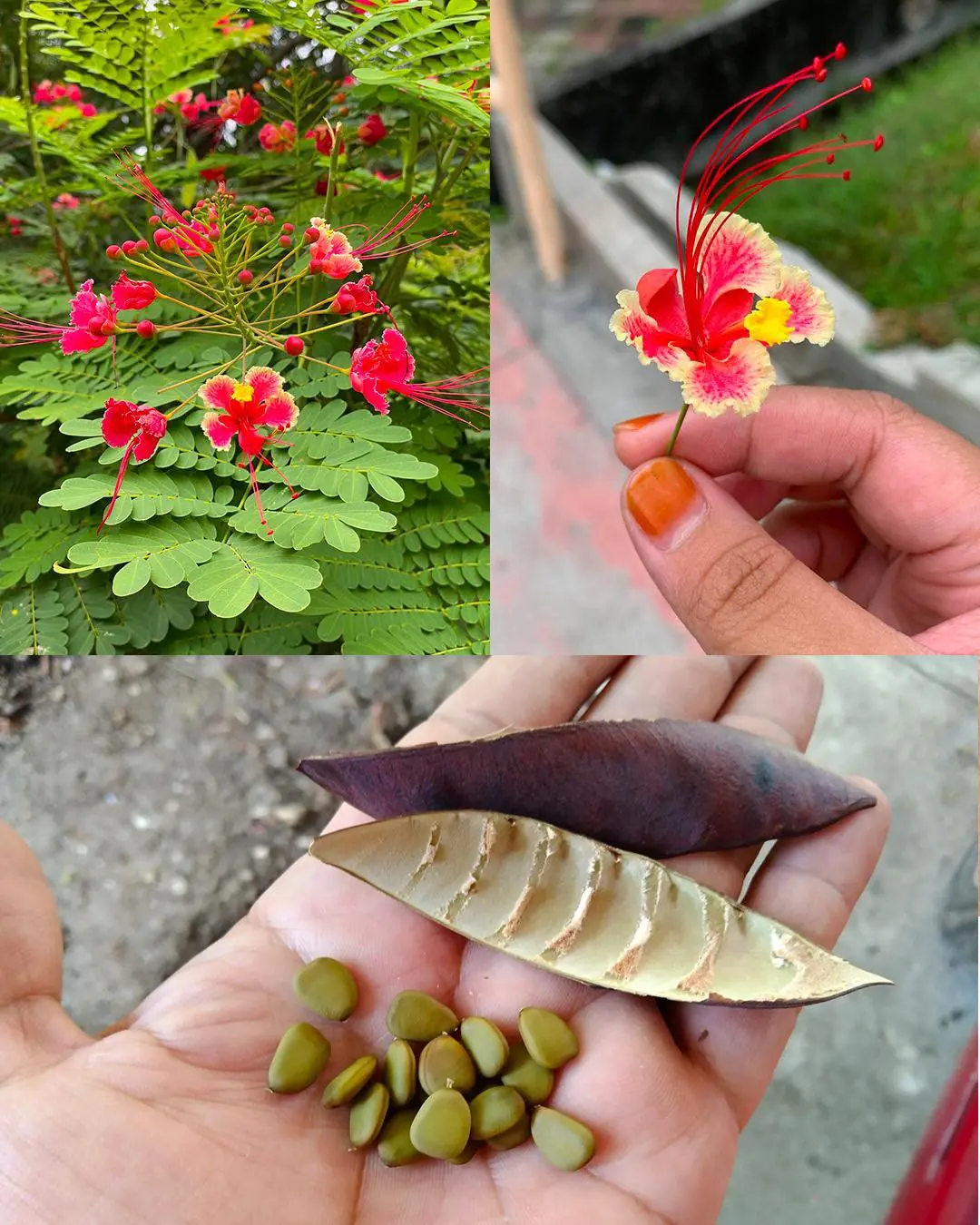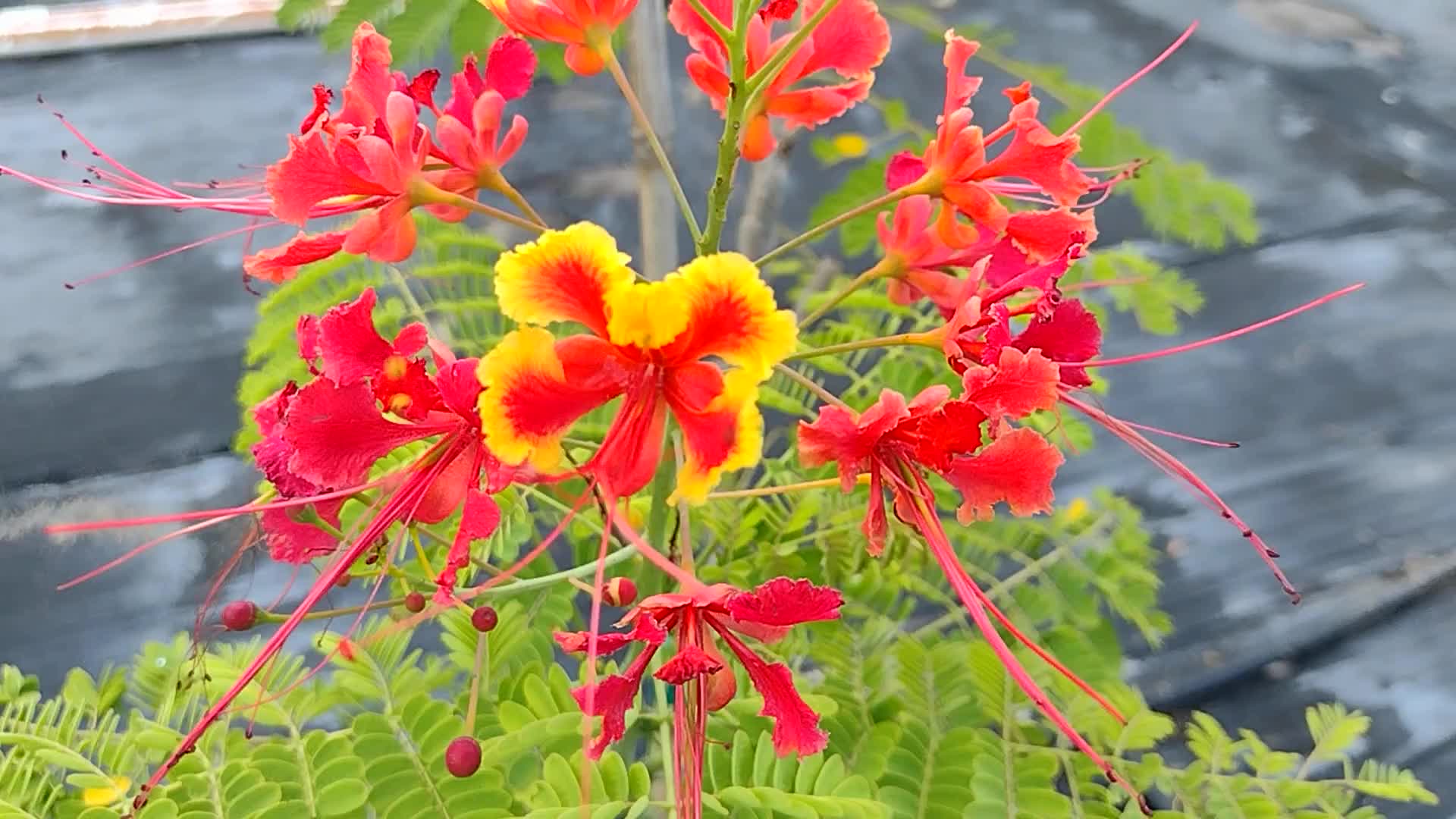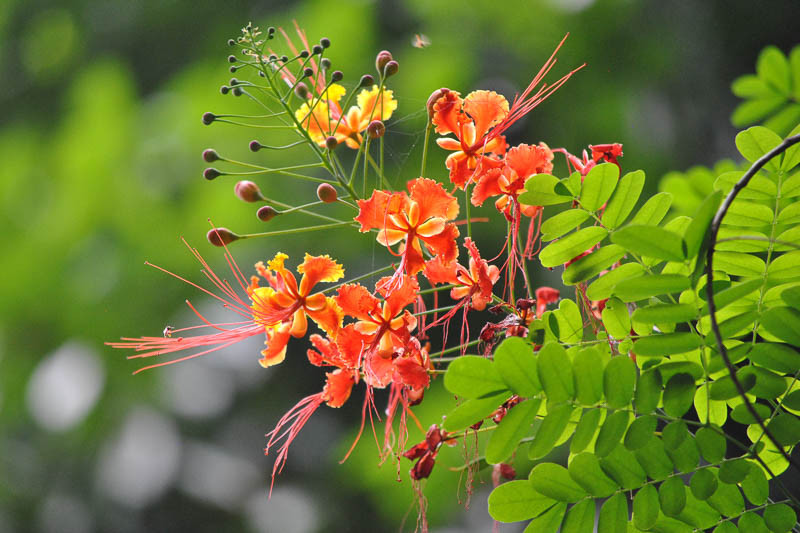
The Amazing Power of Caesalpinia pulcherrima (Peacock Flower)

Nature never stops surprising us - and one of its most vibrant gifts is the Peacock Flower (Caesalpinia pulcherrima). Known for its fiery orange-red blossoms that light up tropical landscapes, this beautiful plant is more than just eye-catching. Beneath its ornamental beauty lies a powerful natural medicine with centuries of traditional use.
Let’s dive into the fascinating history, medicinal value, and modern science behind this extraordinary flower.
🌿 What Is the Peacock Flower?
Caesalpinia pulcherrima, commonly called Peacock Flower, Barbados Pride, Red Bird of Paradise, or Dwarf Poinciana, belongs to the Fabaceae (legume) family.
It is a small shrub native to tropical regions — especially the Caribbean, Central America, and South Asia — and is now cultivated worldwide for both decorative and medicinal purposes.
Its name “pulcherrima” literally means “most beautiful” in Latin — and rightly so. The plant produces clusters of vivid red, orange, and yellow flowers resembling a peacock’s tail, hence the name “Peacock Flower.”
🌺 Traditional Uses Through the Ages
For hundreds of years, indigenous and traditional medicine systems have recognized the therapeutic power of Caesalpinia pulcherrima.
It appears in Ayurvedic, Caribbean, Chinese, and Latin American healing practices.
🕉️ In Ayurveda (India):
-
Used to regulate menstruation and relieve uterine pain.
-
Decoctions of the flowers and leaves are used for fever, cough, and bronchitis.
-
The seeds are used as a mild purgative and anti-inflammatory agent.
🌴 In the Caribbean:
-
The roots and flowers are used to treat skin infections, fever, and digestive problems.
-
It’s also known as a female health tonic used after childbirth.
🌸 In Latin American Herbalism:
-
The plant is used to ease menstrual cramps, reduce inflammation, and calm anxiety.
-
The bark and leaves are prepared as herbal teas to support liver detoxification and respiratory health.
💎 Key Chemical Compounds
Scientific studies have identified several bioactive compounds in the Peacock Flower that explain its healing potential.
These include:
-
Flavonoids (quercetin, kaempferol) – powerful antioxidants that reduce oxidative stress
-
Alkaloids – support pain relief and anti-inflammatory action
-
Tannins – protect cells and reduce microbial infections
-
Saponins – cleanse and support immune function
-
Glycosides – improve cardiac and liver activity
These compounds give Caesalpinia pulcherrima its diverse therapeutic effects - antibacterial, antifungal, anti-inflammatory, and even antidiabetic.

🌿 10 Proven Health Benefits of Caesalpinia pulcherrima
Let’s explore the most well-documented and traditional benefits of this magnificent plant.
1. 🌼 Regulates Menstrual Cycle and Relieves Cramps
Traditionally, Peacock Flower tea is known as a natural emmenagogue - it stimulates menstrual flow and helps relieve abdominal cramps.
It also helps in balancing hormones and reducing premenstrual discomfort.
⚠️ Note: Due to this property, it should not be used during pregnancy.
2. 🌡️ Reduces Fever and Body Heat
The leaves and flowers are often boiled into a tea to help reduce fever, especially during tropical illnesses like malaria or dengue.
Its cooling properties bring down body temperature naturally, making it a gentle antipyretic.
3. 🫁 Supports Respiratory Health
The plant’s extracts have been used in traditional remedies for coughs, bronchitis, and asthma.
The flavonoids and alkaloids relax the bronchial muscles and clear mucus, improving breathing comfort.
A warm decoction of the leaves is often consumed to ease chest congestion and soothe sore throats.
4. 💧 Detoxifies the Liver and Blood
Peacock Flower helps purify the blood and improve liver detoxification.
Its antioxidants aid in neutralizing free radicals and promoting healthy liver enzymes.
In traditional medicine, it’s often combined with turmeric or neem to cleanse the body after illness or fatigue.
5. 🩸 Regulates Blood Sugar Levels
Recent studies suggest that extracts of Caesalpinia pulcherrima may help lower blood glucose levels.
The plant’s compounds improve insulin sensitivity and reduce oxidative stress, supporting metabolic health.
6. 🧠 Calms the Mind and Reduces Anxiety
Peacock Flower tea is sometimes used as a mild natural sedative.
Its calming alkaloids promote relaxation and improve sleep quality without causing dependency.
In Caribbean folk medicine, it’s traditionally used as a stress reliever and mood stabilizer.
7. 🦠 Fights Infections Naturally
Thanks to its antibacterial and antifungal properties, the Peacock Flower is effective in treating minor infections.
Extracts of the bark and flowers have been shown to inhibit common bacteria such as E. coli, Staphylococcus aureus, and Candida albicans.
Topical applications of its leaf paste are used to heal wounds, ulcers, and skin eruptions.
8. 💪 Reduces Inflammation and Pain
The anti-inflammatory compounds in the plant help relieve pain associated with arthritis, injuries, and swelling.
Studies have shown that extracts of the plant inhibit inflammatory enzymes, similar to mild pain relievers.
9. 🌿 Supports Digestive Health
The leaves and flowers stimulate digestion and relieve constipation.
In folk medicine, a mild infusion is used to ease indigestion, stomach pain, and gas.
Its natural saponins also promote gut cleansing and microbial balance.
10. 🌸 Improves Skin Health
Used externally, the Peacock Flower is excellent for cleansing and revitalizing the skin.
Its antioxidants help fight acne, blemishes, and dullness, while its anti-inflammatory nature soothes rashes and irritation.
A paste made from the petals can be applied to heal wounds, burns, and insect bites.

🧪 What Science Says
Modern pharmacological research supports many of the plant’s traditional uses.
-
A 2014 study published in the Journal of Natural Remedies confirmed the antioxidant and antimicrobial activity of Caesalpinia pulcherrima flower extracts.
-
Research from Phytomedicine (2017) demonstrated anti-inflammatory and analgesic effects, validating its use for pain relief.
-
Another study (2019, Asian Pacific Journal of Tropical Biomedicine) reported the plant’s potential antidiabetic and hepatoprotective (liver-protecting) properties.
These findings align closely with what traditional healers have known for centuries — that this bright flower is more than ornamental; it’s medicinal.
🌺 How to Use Peacock Flower Safely
Here are a few traditional and modern ways to use the plant for health and wellness.
☕ 1. Peacock Flower Herbal Tea
Ingredients:
-
1 tablespoon dried flowers or leaves
-
2 cups water
-
Optional: honey or lemon
Instructions:
-
Boil the flowers/leaves in water for 10 minutes.
-
Strain and let cool slightly.
-
Drink once daily for detox or menstrual support.
Benefits:
-
Helps detoxify the liver
-
Promotes relaxation
-
Relieves mild cramps
⚠️ Avoid during pregnancy.
💧 2. Anti-Inflammatory Decoction
Ingredients:
-
10 g of dried roots or bark
-
3 cups of water
Instructions:
-
Boil until the water reduces by half.
-
Strain and drink ½ cup twice daily.
Uses:
-
Reduces fever, inflammation, and joint pain.
🧴 3. Skin-Healing Paste
Ingredients:
-
Fresh flower petals
-
1 teaspoon turmeric powder
-
A few drops of coconut oil
Instructions:
Grind into a smooth paste and apply to affected skin areas.
Benefits:
-
Treats acne and skin infections
-
Soothes burns and insect bites
⚠️ Precautions and Side Effects
While Caesalpinia pulcherrima offers many health benefits, it must be used responsibly.
-
Pregnancy Warning: The plant can induce uterine contractions; do not use during pregnancy.
-
Dosage Control: Excessive use may cause stomach upset or diarrhea.
-
Allergies: Some people may develop mild skin irritation when using the raw plant.
-
Consultation: Always consult a qualified herbalist or healthcare provider before internal use.
🌿 Ecological and Symbolic Value
Beyond its healing potential, the Peacock Flower has cultural and ecological significance:
-
It attracts bees, butterflies, and hummingbirds, supporting pollination.
-
In some cultures, it symbolizes purity, grace, and strength.
-
The bright flowers are used in Hindu temple offerings and tropical ceremonies.
In many gardens, it’s cherished not only for its beauty but for its ability to thrive in hot, dry conditions, symbolizing endurance and vitality.
🌞 Conclusion: A Flower of Beauty and Healing
The Peacock Flower (Caesalpinia pulcherrima) stands at the intersection of beauty and medicine.
Its stunning blossoms decorate gardens, but its real power lies in the centuries of healing wisdom it carries.
From women’s health and liver detox to anti-inflammatory and antimicrobial properties, this plant continues to prove that nature’s most beautiful creations often hold the deepest healing secrets.
So the next time you see the radiant Peacock Flower swaying in the sun, remember - it’s not just a plant of beauty, but a living symbol of balance, strength, and natural wellness.

News in the same category


Why You Keep Waking Up Between 3 and 4 AM - 4 Health Issues Your Body May Be Signaling

Indoor Air Quality: 6 Common Household Items That May Affect Your Lungs — And How to Use Them Safely

5 common mistakes when using yogurt that can be harmful to your health that you may not know

Scientists May Have Actually Found One Of The Causes Of Autism

Itching in 9 Areas: A Warning Sign of Malignant Tumors, Number 7 Is the Most Common

Doctors Warn: Stroke May Present a Subtle Early Sign Up to Three Months Before It Occurs

7 Signs of Mini Stroke in The Elderly

8 Early Warning Signs Of Ovarian Can:cer You Shouldn’t Ignore

What Does It Mean When You Dream About Someone Close Who’s Died?

5 Alarming Stroke Warning Signs to Watch for in Young People

What Are Eye Floaters? Here What To Do If you Start Seeing Them, According to an Eye Doctor

36-Year-Old Teacher Dies From Diabetes Doctors Say Was Triggered By Everyday Foods

Discover Love in the Little Things: Everyday Connections

Itching in 9 Areas: A Warning Sign of Malignant Tumors, Number 7 Is the Most Common

The Hidden Danger Hour: Doctors Warn Sleeping at This Time Could Trig:ger 4 Serious Health Problems

Why Many Modern Hotels Use Transparent Glass Bathrooms - The Real Reasons Behind the Design

3 “Golden” Foods That Help Women During Menopause

8 foods that ki.ll can.cer cells

Your body can sometimes show early signs of cardiovascular stress
News Post

Tomato Basil Bruschetta

Mediterranean Tortellini Pasta Salad

Swollen Feet? Don’t Ignore This Clear Red Flag — Here’s What It Really Means

Doctors Reveals That Eating Apples Causes

How to Deep-Clean Bed Pillows and Restore Them to Cloud-Like Freshness—Naturally

Why You Keep Waking Up Between 3 and 4 AM - 4 Health Issues Your Body May Be Signaling

Indoor Air Quality: 6 Common Household Items That May Affect Your Lungs — And How to Use Them Safely

What are the health consequences of dehydration?

5 common mistakes when using yogurt that can be harmful to your health that you may not know

Scientists May Have Actually Found One Of The Causes Of Autism

Itching in 9 Areas: A Warning Sign of Malignant Tumors, Number 7 Is the Most Common

Doctors Warn: Stroke May Present a Subtle Early Sign Up to Three Months Before It Occurs

7 Signs of Mini Stroke in The Elderly

8 Early Warning Signs Of Ovarian Can:cer You Shouldn’t Ignore

What Does It Mean When You Dream About Someone Close Who’s Died?

5 Alarming Stroke Warning Signs to Watch for in Young People

What Are Eye Floaters? Here What To Do If you Start Seeing Them, According to an Eye Doctor

36-Year-Old Teacher Dies From Diabetes Doctors Say Was Triggered By Everyday Foods

Discover Love in the Little Things: Everyday Connections
